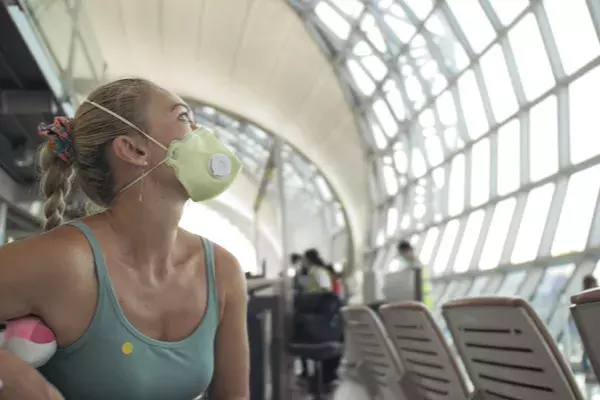04 June 2020 | Blog
Focus for airlines and airports - Q&A with IATA
Contributors:
Al Tredinnick – Head of Commercial, 15below
Hasse Jørgensen - Senior Manager Passenger Experience, IATA
What is the biggest challenge for IATA at the moment?
Hasse: We've been shaping our guidance for the industry on how to restart, and detailing what could be a layered approach to enable the re-opening of the borders and the lifting of travel restrictions.
And even though we’re working on getting some effective guidance in place, amending measures in airports is proving to be – at least in the short term – the greatest challenge that we, and passengers, will face. In particular when volumes pick up again, getting that many passengers through the airport safely with new measures in place. This is going to be a huge task.
And it has forced us to ask ourselves if we will ever be able to provide a level of flight schedules that we’re used to, whilst also keeping connection times to a minimum and maintaining existing turnaround times. It’s undoubtedly all going to change, at least until some measures can be removed, and I think everyone’s expectations will have to be realigned.
So, what's life like at IATA? You must have a lot of important stuff to work out!
Hasse: Yes, the industry was indeed expecting some initial direction to restart operations, and our members asked us to engage with governments to discuss conditions for reopening of borders. Usually, we would meet face-to-face with our members and partners to discuss and shape industry positions and to deliver recommended practices and technical standards.
And because I deal with disruption management, by nature, all the people that would usually be contributing in this kind of area of expertise either have their hands completely full, or they have experienced a drastic change in their working schedule. So, we are currently terribly lacking in expertise and support in this area.
Are things getting better on that front?
Hasse: It is too early to say – and we need to give everybody time – but I’m sure our experts will reengage as soon as they have the opportunity. There is a handful of people that have been able to carry on contributing, but it’s not happening on a regular basis.
In this work, I do need to be in contact with people that are dealing with this in their daily lives. Our partnerships are paramount in providing a clear picture of the situation on the ground and deliver meaningful guidance.
Luckily there are a few airlines that are seeing this time as an opportunity to improve things that they didn’t have the time to look at before. So that’s really encouraging to see.
Also, the work we are doing with governments is critical to ensure a high level of harmonization of the new measures across the globe.
So, what are you focusing on at the moment?
Hasse: One of the first things we're having to solve is a whole different approach to getting passengers through airports and onto planes.
IATA took the lead to draft the guidance material to fill a void in the industry and this helped further discussions between partner organizations like ACI, ICAO and WHO, on top of multiple states and other associations around the world. The work highlighted a few unknown areas that need to be aligned; one of them being health declarations and the interaction between all other measures.
When and how do we deal with the whole health issue in the passenger process? I’d say the biggest challenge is to globally harmonize the new measures that will be required to reopen the borders. One significant risk in all of this is that governments are setting out requirements and asking the airlines or airports to carry out what needs to be done and then shifting responsibility.
But we’re working really hard to get a common understanding of what needs to be delivered and what level of responsibility each party will take.
Al: One of the things we're doing is to work with airlines to make sure they’re communicating with passengers well in advance, such as messaging people across different channels to encourage them to accept a schedule change. And we could do the same for health declarations or visas so that as few people as possible are dealing with it at the airport, for everyone's benefit.
And it's going to bring the whole topic of contact details to the forefront again, isn’t it? Because if people don’t put their contact details in the bookings, it's going to get super complicated, don’t you think?
Hasse: I think one of the most valuable things an airline can do is to proactively keep their passengers in the loop. We’ve also looked at the many practices that several countries have set up, including government portals to collect additional passenger information they need (up to date contact details, travel history, health information, etc.). This has proven to be very effective and it’s the direction that the international community is taking.
It’s important to generate a dialogue between the airline and the customer. And it’s not exactly a hugely technical solution, but it empowers the passenger and gives them confidence, which is going to be absolutely key to recovery.
Al: I think one of the things that's going to be a real shame about the contact detail issue is that the age-old battle between travel agents and the airlines about contact details is going to look like a pretty thin argument at this stage. And if you’re a customer who didn't get looked after by the airline because they didn’t have any way of getting in touch, you’re going to remember it for a long time. And it's not going to have done anyone any favours keeping contact details secret, because this is so much bigger than that. So hopefully that will straighten things out a little bit.
Hasse: And contact tracing goes way beyond a single flight. It’s the reason why governments are setting up portals to get information on people independently of the mode of travel they use. A few are also working with contact-tracing apps that can provide an additional level of confidence to passengers.
What else should airlines be focusing on now, as a way to build passenger confidence?
Hasse: So, in terms of handling the passenger process at airports and the measures that need to be in place on board a flight and so on, it’s not only a health issue, but it's also about saying, "You don’t have to worry. Everything has been taken care of.”
And also providing guidance on whether it’s mandatory to wear a mask and any other considerations like that.
Is the middle seat issue top of your agenda to resolve?
Hasse: It is important to communicate to passengers that the multi-layered approach is not the same on the ground as it is on-board as we are not relying on the same tools. On the ground, social distancing, sanitization, and the wearing of masks are part of the basic protective elements. Whereas on board the aircraft we rely on effective air (HEPA) filters, seat positioning and masks to prevent contamination. We are constantly working with the aeronautical medical community to monitor the situation and until now no evidence has demonstrated the need to block the middle seat.
Another issue for me is the fact that harmonized requirements are not in place everywhere. It is a big mess. And it’s a concern not only for airlines who must comply with multiple protocols and processes, but also for the passenger who faces requirements being changed overnight.
And that is basically making the whole travel experience very uncomfortable for everyone involved. And while we don't have a common approach and countries continue to deal with things in their own way, recovery for the industry is going to be a big challenge.
But a lot of work has been done in that area with health authorities and ICAO to get a common understanding of what needs to be done. The good thing about our situation is that everyone understands the sense of urgency to restart the industry while mitigating the risks of COVID-19 — especially a second wave. No one has time to mull these things over anymore. So at least everyone agrees that speed is critical.
And even though some countries are opening up now, these things are changing at a different pace from region to region, so we are working in very unpredictable and changeable times.
Do you have a message for airlines?
Hasse: Our thoughts are with our colleagues working relentlessly to restart the operations of their airlines. We praise their courage and their continuous work. It is a difficult time and some of our members are going through very painful and challenging restructures. The face of the aviation industry is certainly going to change, and IATA wants to be present, strong and ready to help its members.
A significant number of long-term projects that were in process before the COVID-19 crisis have been put aside temporarily in order to deliver urgent guidance. And that’s exactly what IATA is here for. Our main target right now is providing guidance to airlines and airports on how to deal with the period post-lockdown, and the industry restart.
We are offering a lot of webinars at the moment, trying to give airlines and airports confidence that we are working hard and are here to help them. IATA is running nearly 100 workstreams simultaneously at the moment to deliver special training during a time of mass confusion. Airlines can access that training here:
• All virtual classrooms
• All distance-learning (e-books / e-Learning)



